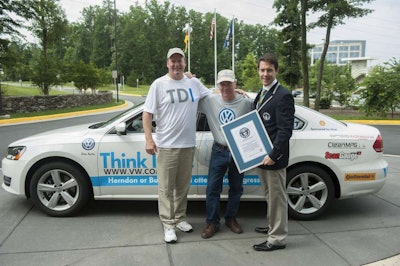 Primary driver Wayne Gerdes, left, Bob Winger and Guinness World Records adjudicator Philip Robertson with the Passat TDI. Credit: Volkswagen
Primary driver Wayne Gerdes, left, Bob Winger and Guinness World Records adjudicator Philip Robertson with the Passat TDI. Credit: VolkswagenAdd another feather in the cap of diesel engines. Volkswagen’s diesel-powered Passat TDI recently went on a road trip of all 48 contiguous U.S. states, covering 8,122 miles of road.
The kicker: the Passat only needed 105 gallons of fuel to do it.
For those of you without a calculator handy that means the Passat achieved an incredible fuel efficiency of 78 mpg on the trip. The total beat a previous record of 68 mpg, enough for the Guinness Book of World Records to award the Passat with its record for “lowest fuel consumption—48 U.S. states for a non-hybrid car”.
What’s funny is that the distinction “for a non-hybrid car” is meant to remove an unfair advantage for hybrids. However, the Passat’s total was actually 13 mpg better than the best fuel economy achived by a hybrid to date of 64.6 mpg.
The EPA rates the Passat’s fuel economy at 43 miles per gallon on the highway when equipped with the six-speed manual transmission. Volkswagen says the Passat TDI can travel nearly 800 miles before needing to refuel.
Interest in diesel vehicles here in the U.S. has exploded as of late. Volkswagen has had a lot to do with that trend and, unsurprisingly, fuel economy topped a recent list of reasons Americans gave of why they are considering buying a diesel vehicle.
It should be noted that it wasn’t exactly an everyday driver behind the wheel of the Passat. Wayne Gerdes, the founder of cleanmpg.com, an automotive journalist and an experienced hypermiler who has set mpg records in more than 100 vehicles, was the Passat’s primary driver.
Gerdes did offer up some hypermiling tips for beginners. In addition to basics like obeying the speed limit and avoiding heavy breaking and acceleration, Gerdes suggests that rather than reacting to the terrain of where you’re currently driving, look for impediments or topography 15 to 45 seconds in advance and use downhill momentum to cost into uphill sections.









